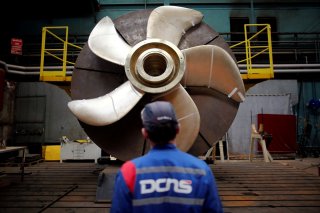Arihant-Class Missile Submarines: India's Navy Is Getting a New SSBN
India has commissioned its second Arihant-class nuclear-powered ballistic missile submarine (SSBN), INS Arighat, significantly advancing its strategic maritime capabilities.
Summary and Key Points: India has commissioned its second Arihant-class nuclear-powered ballistic missile submarine (SSBN), INS Arighat, significantly advancing its strategic maritime capabilities.
-The vessel, commissioned after a decade of construction, is an upgraded version of the INS Arihant, which had faced significant setbacks due to a near-sinking incident in 2017.
-INS Arighat, equipped with K-15 Sagarika or K-4 submarine-launched ballistic missiles, enhances India's nuclear deterrence, particularly against China and Pakistan.
-The Indian Navy plans further investments, including commissioning additional SSBNs and building six nuclear-powered fast attack submarines to counter China's growing maritime presence in the Indian Ocean.
India Has Commissioned Second Arihant-class Submarine
In 2017, India launched a new, state-of-the-art $2.9 billion nuclear submarine. Instead of being a moment of pride for the Asian nation, it became the butt of a joke when a hatch was left open on INS Arihant , which allowed seawater to rush in, almost sinking the boat in the process. It resulted in substantial damage to the propulsion compartments, and numerous pipes that ran through the submarine had to be cut out and replaced.
The nuclear submarine was the first of an expected five in class, designed and constructed as part of the Indian Navy's Advanced Technology Vessel project.
Now finally, seven years later, the Indian Navy commissioned the second Arihant-class nuclear-powered ballistic missile submarine (SSBN), and no doubt New Delhi hopes to avoid any similar costly (and embarrassing) mistakes.
Enter the INS Arighat
It was just last week that the INS Arighat officially entered service. The upgraded variant of the lead vessel was handed over at the Indian Navy's Ship Building Centre (SBC) in Visakhapatnam on the east coast of India. It had "been under construction for more than a decade," international military analyst firm Janes reported.
"The technological advancements undertaken indigenously on Arighat make it significantly more advanced than its predecessor Arihant," the Indian Ministry of Defence said in a statement to the media. "The presence of both INS Arihant and INS Arighat will enhance India's capability to deter potential adversaries and safeguard its national interests."
A third SSBN, INS Aridaman, is now on track to be commissioned next year, while a fourth ballistic missile submarine is now under construction. Both of those boats are expected to displace about 1,000 tonnes more than INS Arihant, as each is equipped with the K-4 SLBM. At 6,000 tonnes, INS Arihant is slightly smaller than China's People's Liberation Army Navy's (PLAN's) Type 094 Jin-class SSBNs but can carry a comparable number of missiles.
"The commissioning of INS Arighat marks a significant advancement in India?s strategic submarine manufacturing capabilities, emphasising the country?s commitment to further strengthen its strategic nuclear triad. Armed with twelve K-15 Sagarika or four K-4 submarine-launched ballistic missiles, INS Arighat substantially enhances India?s second-strike capability while providing a robust deterrence against its nuclear armed neighbors Pakistan and China. By advancing the development of these indigenous platforms, India is also bolstering its strategic autonomy in producing critical defence technologies," Kandlikar Venkatesh, a defense analyst at international analytics firm GlobalData, told Asia Pacific Defense Reporter.
"The growing maritime presence of China?s People?s Liberation Army Navy (PLA Navy) in the Indian Ocean Region (IOR) highlights the urgent need for India and its partners to reinforce their naval capabilities," Venkatesh added.
GlobalData has projected that New Delhi will invest $31.6 billion in submarines over the next decade, and the Indian Navy has already announced plans to build six nuclear-powered fast attack submarines. Such boats could be employed to counter the PLAN's surface warships including its growing fleet of aircraft carriers, as well as Beijing's SSBNs.
Author Experience and Expertise: Peter Suciu
Peter Suciu is a Michigan-based writer. He has contributed to more than four dozen magazines, newspapers, and websites with over 3,200 published pieces over a twenty-year career in journalism. He regularly writes about military hardware, firearms history, cybersecurity, politics, and international affairs. Peter is also a Contributing Writer for Forbes and Clearance Jobs. You can follow him on Twitter: @PeterSuciu. You can email the author: [email protected].
Image Credit: Creative Commons.


